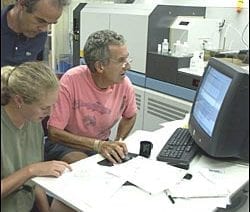Press Room
Life on Earth and in the universe is the theme of a traveling exhibit on astrobiology at the Woods Hole Oceanographic Institution (WHOI) Exhibit Center during July and August. The interactive exhibit focuses on clues for understanding how life evolved…
Ship strikes and entanglement in fishing gear are threatening the survival of the North Atlantic right whale, one of the most endangered whales with an estimated population of about 350. With eight recorded deaths in the past 16 months and…
The Woods Hole Oceanographic Institution (WHOI) is celebrating 75 years of ocean research, education and exploration in 2005 with a series of activities this summer and fall, ranging from an “unboat” regatta, public open house and science symposium, to publication…
Contacts: WHOI: Shelley Dawicki 508-289-2270 or 508-566-7017 (mobile) NOAA: Ben Sherman 202-253-5256 (mobile) WHAT: Spring 2005 brought the worst “bloom” of the toxic alga Alexandrium fundyense since a massive outbreak occurred in 1972 in the New England region. Officials from…
Scientists have long known of organisms adapted to environments that appear inhosptable to any form of life, living in the 600-700??F waters of hydrothermal vents on the sea fl oor, in pitchdark mine shafts a mile below ground, or clinging…
Currents, fronts and eddies, often called the internal weather of the sea, are major components of ocean circulation and can change the chemical and biological environment in the ocean. Four cruises are being conducted as part of the Eddy Dynamics,…
Bubbles stream from vents surrounding misshapen cones formed by thick liquid oozing from the sea floor. It may sound like a hydrothermal vent field near a mid-ocean ridge, but these vents are located in shallow water, only a kilometer (about…
Additional Contact: Justin Kenney The Pew Charitable Trusts 215-575-4816, jkenney@pewtrusts.org (Washington, D.C.) The Pew Charitable Trusts, in collaboration with the Woods Hole Oceanographic Institution (WHOI), announces the establishment of the Marine Aquaculture Task Forcecomprising leaders from the worlds of science,…
Large regions of the North Atlantic Ocean have been growing fresher since the late 1960s as melting glaciers and increased precipitation, both associated with greenhouse warming, have enhanced continental runoff into the Arctic and sub-Arctic seas. Over the same time…
Using inflatable boats, a portable depth sounder with GPS, and a REMUS autonomous underwater vehicle, a team of scientists and engineers has created the first detailed, comprehensive chart of the ocean floor around Palmer Station in Antarctica, revealing previously unknown…
With hurricane season arriving June 1, along with predictions of an above normal number of major storms in the Atlantic and Gulf States, understanding how the ocean and atmospheric interact and what role changing climate has on the formation of…
As summer vacations approach, beachgoers might want to bring along a guide to what they and their children will see on the beach and in the water. WHOI scientists and educators have created Beachcomber’s Companion for adventures at the beach.…
Commonly called “red tides,” harmful algal blooms, or HABs, are an abundance or “bloom” of single-celled marine algae called phytoplankton that grow and multiply under the right conditions. Among the thousands of phytoplankton species, most are harmless and only a…
Woods Hole Oceanographic Institution recently honored The G. Unger Vetlesen Foundation of New York with the prestigious Cecil H. Green Award. The award, named for Texas Instruments’ founder and philanthropist Cecil H. Green, is presented to those who have made…
With shellfish beds from Maine to the Cape Cod coast closed from the largest outbreak of red tide in 12 years in Massachusetts Bay, scientists from the Woods Hole Oceanographic Institution (WHOI) are studying the algae that causes these “red…
An international team of scientists, led by researchers at the Woods Hole Oceanographic Institution, Scripps Institution of Oceanography, University of Oregon and University of Sydney, has discovered an active underwater volcano near the Samoan Island chain about 2,400 miles southwest…
Cadmium, commonly considered a toxic metal and often used in combination with nickel in batteries, has been found to have a biological use as a nutrient in the ocean, the first known biological use of cadmium in any life form.…
Woods Hole Oceanographic Institution (WHOI) Senior Scientist Stanley Hart of the Geology and Geophysics Department was recently elected a Fellow of the American Academy of Arts and Sciences, one of the oldest learned societies in the nation. Dr. Hart is…
In 2002, researchers diving in the submersible Alvin returned to the Galápagos Rift, a mid-ocean ridge about 250 miles from the Galápagos Islands in the eastern Pacific Ocean where hydrothermal vents and exotic organisms were first found in 1977. They…
A miniature computer weighing less than 5 ounces attached to the backs of beaked whales with suction cups is providing new clues to the behavior and sounds made by the deep-diving reclusive species. Little is known about these mid-sized toothed…

